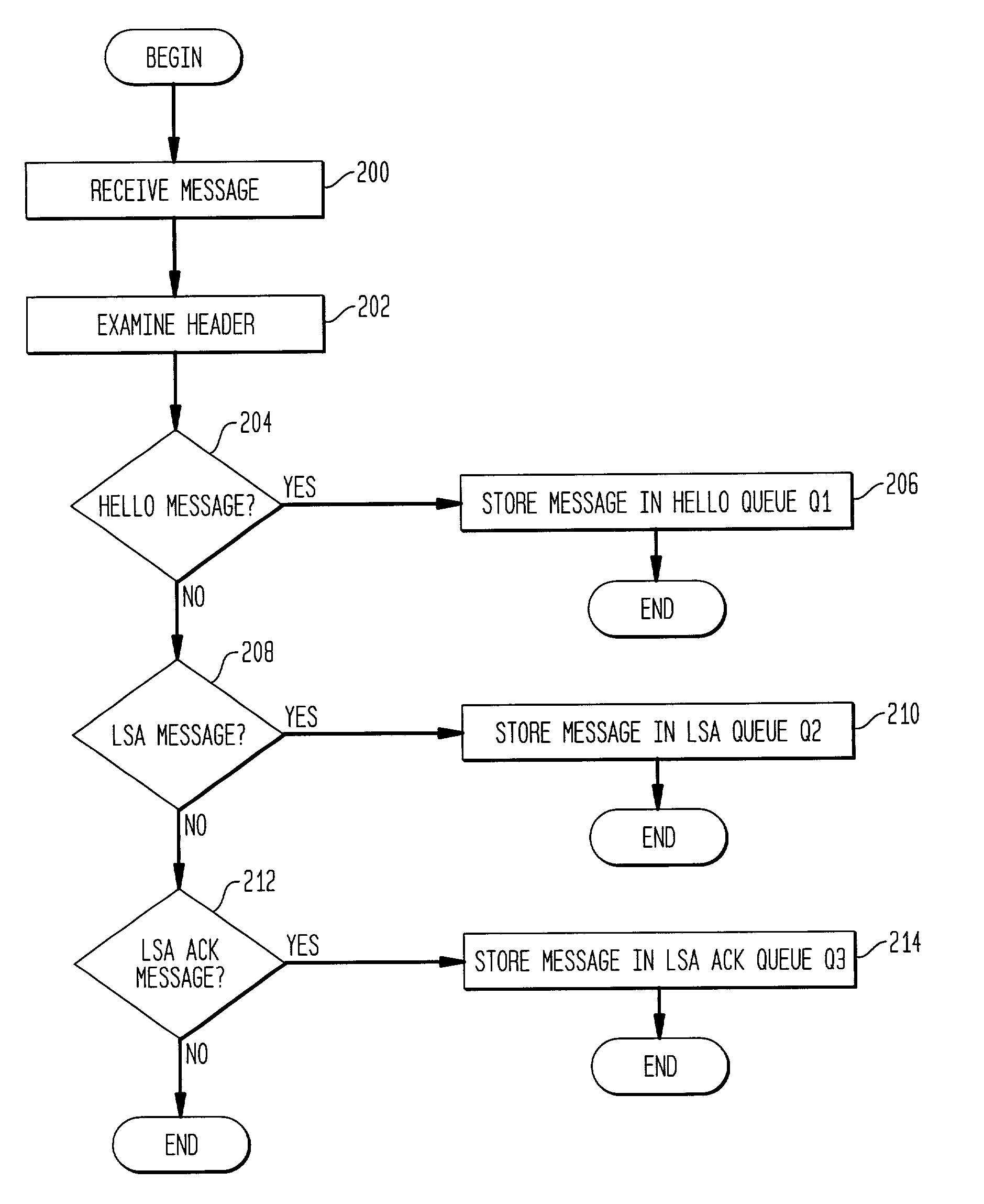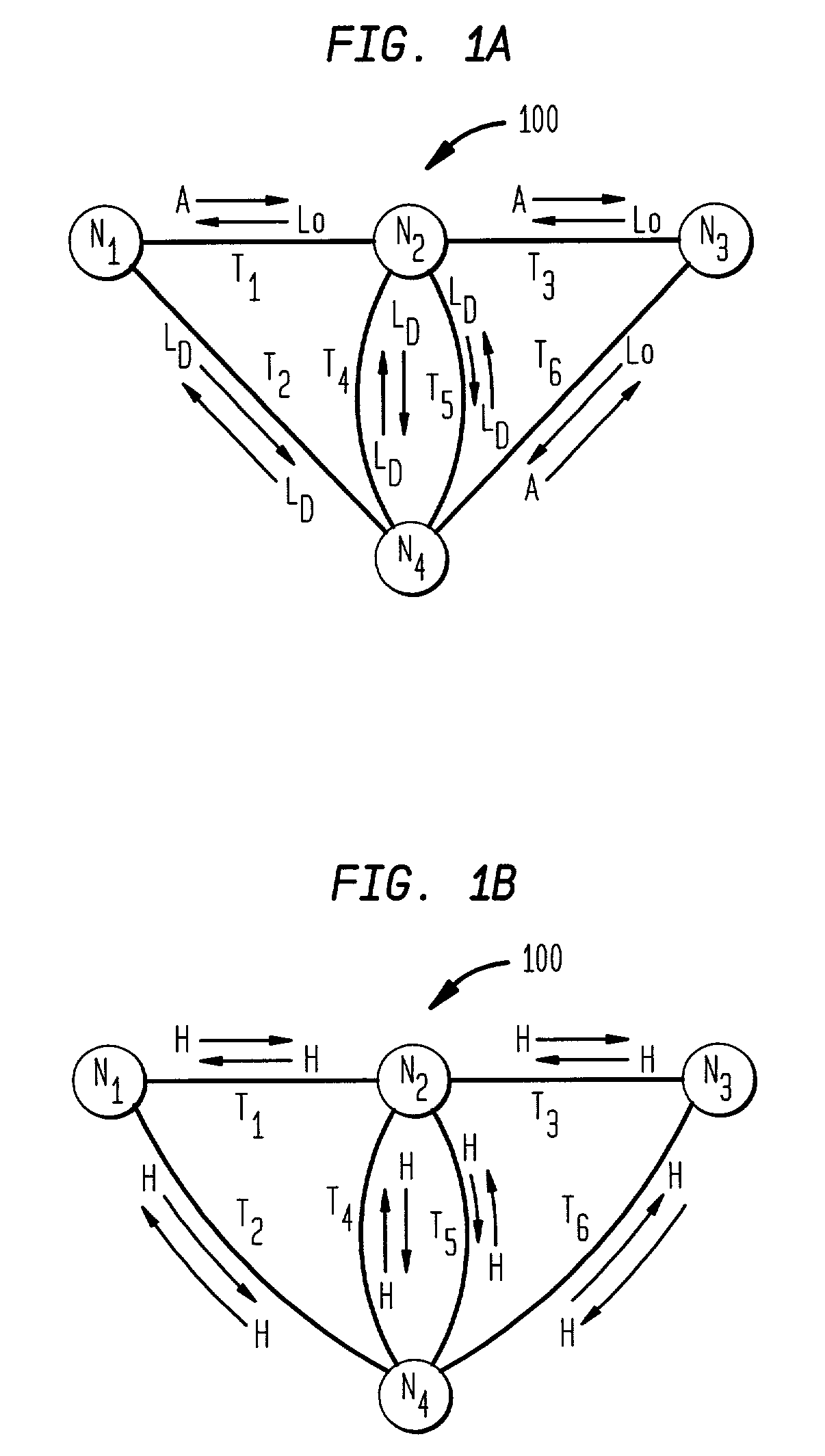Link state network having weighted control message processing
a link state network and message processing technology, applied in the field of communication networks, can solve the problems of hardware failure or software upgrade, control message generation, and certain message types may not be timely processed, and achieve the effect of enhancing network reliability and scalability
- Summary
- Abstract
- Description
- Claims
- Application Information
AI Technical Summary
Benefits of technology
Problems solved by technology
Method used
Image
Examples
example 1
Conventional HELLO Message Processing
[0059]An LSA storm of size S is generated within an area of the network as a result of the failure or recovery of a single trunk, a group of trunks, a single node or a group of nodes. Focusing on a node N within the area, let L be the number of trunks attached to node N, and P be the average processing time needed either to receive a message or to transmit it over a single trunk. HELLO messages are exchanged every T seconds over every trunk. If no HELLO message is received for n Hello intervals (i.e., a period of time nT) then the trunk is declared down. R is the LSA retransmission timer value, i.e., if no acknowledgment is received for an LSA transmitted to a neighboring node within a time-period R, then it is retransmitted.
[0060]In a conventional link state network, for each LSA message in the LSA storm, node N will get one original message over one of the L trunks, acknowledge it, and flood duplicate LSA messages over all trunks except the one...
example 2
HELLO Message Processing in Accordance with the Present Invention for Reducing or Eliminating the Chance of Declaring Trunks Down Even when they are Actually Up
[0062]As described above, the fraction of the node processor dedicated to processing Type i messages is FWiPi / (∑j=16WjPj)
where F is the fraction of node processor dedicated to routing control work, and Wi, Pj are the relative weight and processing time, respectively, for type i message. The rate at which type i messages may be processed is therefore FWi / (∑j=16WjPj).
Consider the guaranteed minimum rate at which HELLO messages can be processed. Note that the type 1 (Q1) message represents HELLO messages received from another node and the type 4 (Q4) message represents HELLO messages generated by node N, i.e., HELLO refresh messages. The minimum processing rate occurs when the message processing times Pjs get their maximum possible values. Among the 6 message types, the processing times for types 1, 4 and 3 (HELLOs and ackn...
example 3
Conventional OSPF Leading to LSA Retransmission Lockout
[0064]Consider the same LSA storm example as in Example 1. The LSAs in the storm originated by node N are transmitted over all L trunks and other LSAs are transmitted over all trunks except the one on which the message came. So, the total number of LSAs transmitted by node N is about SL. The maximum rate of LSA generation at node N due to retransmission timer expiry is about SL / R. The maximum rate at which node N can process the retransmitted LSAs is (1 / P). So, the condition for LSA retransmission lockout (i.e., the condition under which the node processor enters an infinite loop processing only retransmissions and nothing else) is given by SLR>IPor,(4)S>RLP(5)
Assuming L=50, R=5 seconds and P=1 milliseconds, LSA retransmission lockout can occur for any storm of size S>100.
[0065]It should be noted that there are two opposing effects that have not been taken into account in the simple model above. The first effect is that, some ...
PUM
 Login to View More
Login to View More Abstract
Description
Claims
Application Information
 Login to View More
Login to View More - R&D
- Intellectual Property
- Life Sciences
- Materials
- Tech Scout
- Unparalleled Data Quality
- Higher Quality Content
- 60% Fewer Hallucinations
Browse by: Latest US Patents, China's latest patents, Technical Efficacy Thesaurus, Application Domain, Technology Topic, Popular Technical Reports.
© 2025 PatSnap. All rights reserved.Legal|Privacy policy|Modern Slavery Act Transparency Statement|Sitemap|About US| Contact US: help@patsnap.com



